Charles E W Bean, Diaries, AWM38 3DRL 606/247/1 - 1917 - 1933 - Part 14

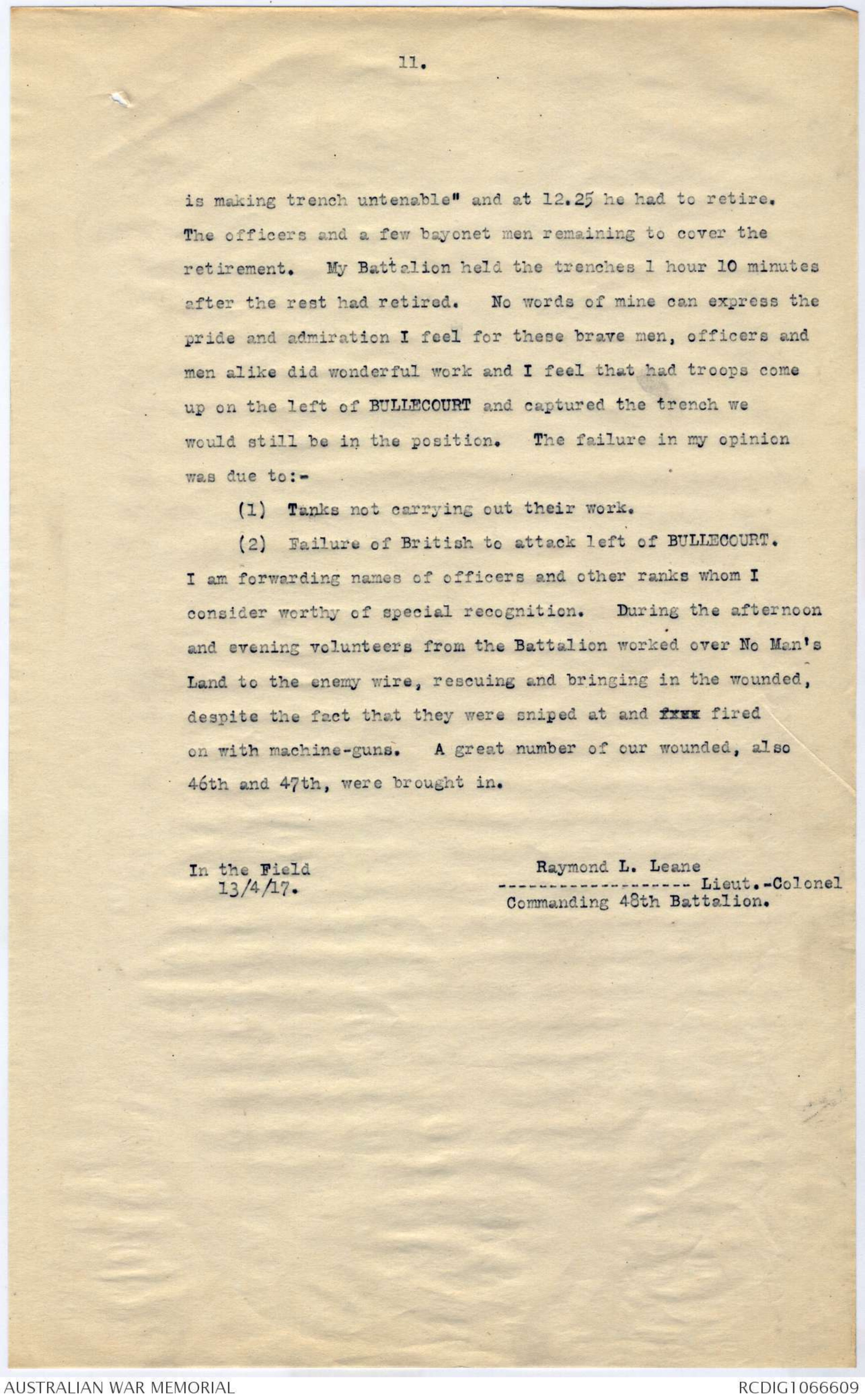
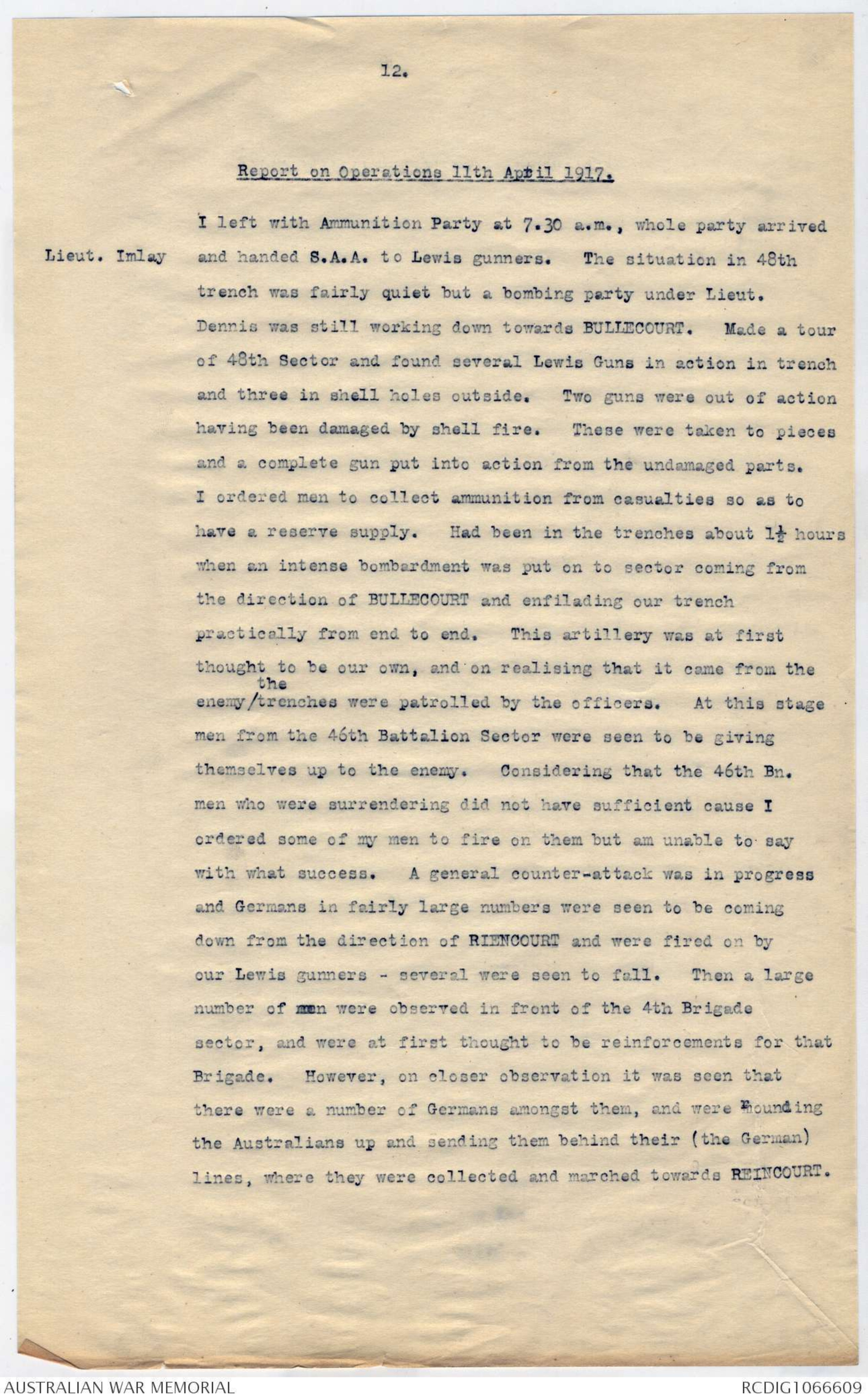
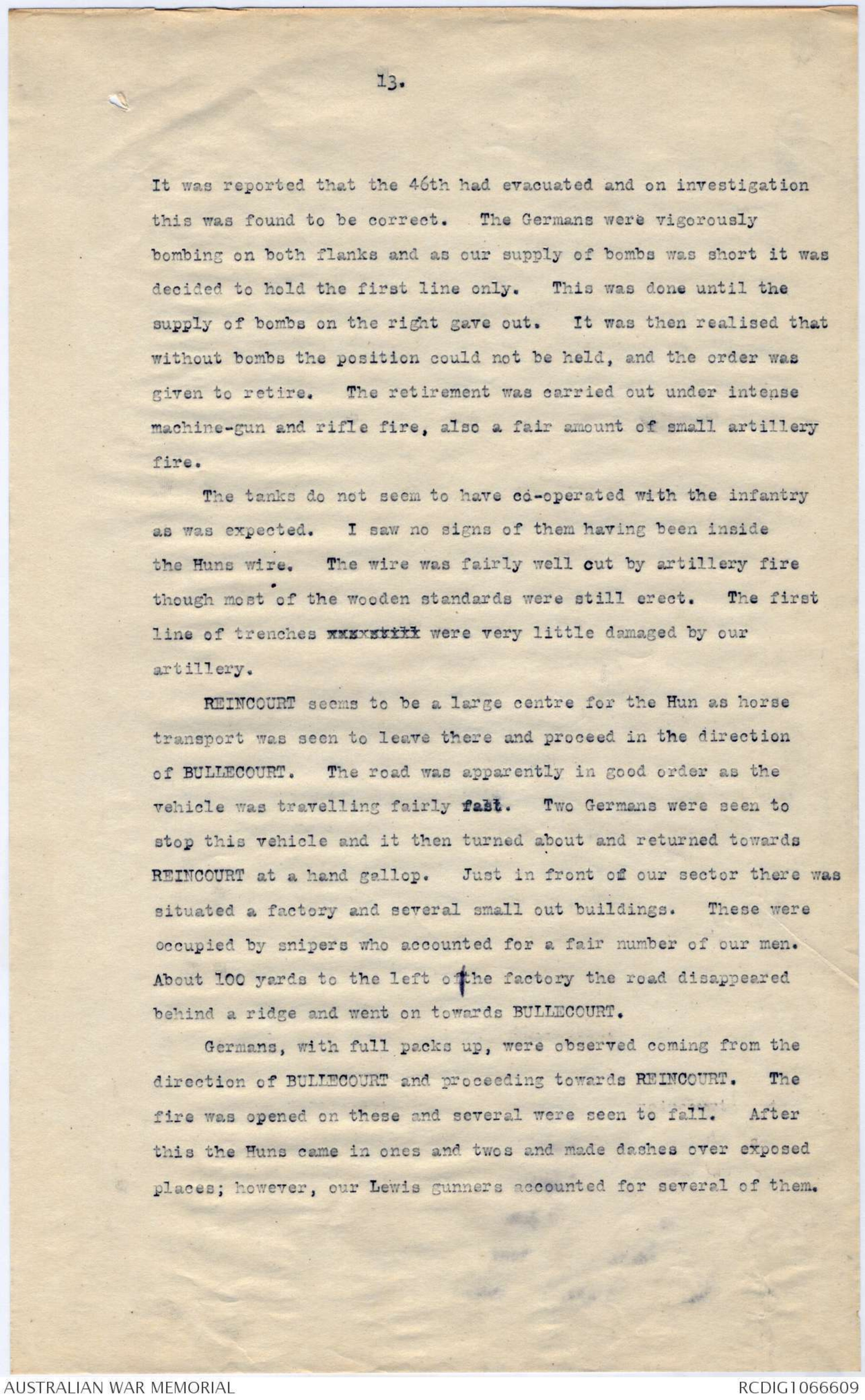
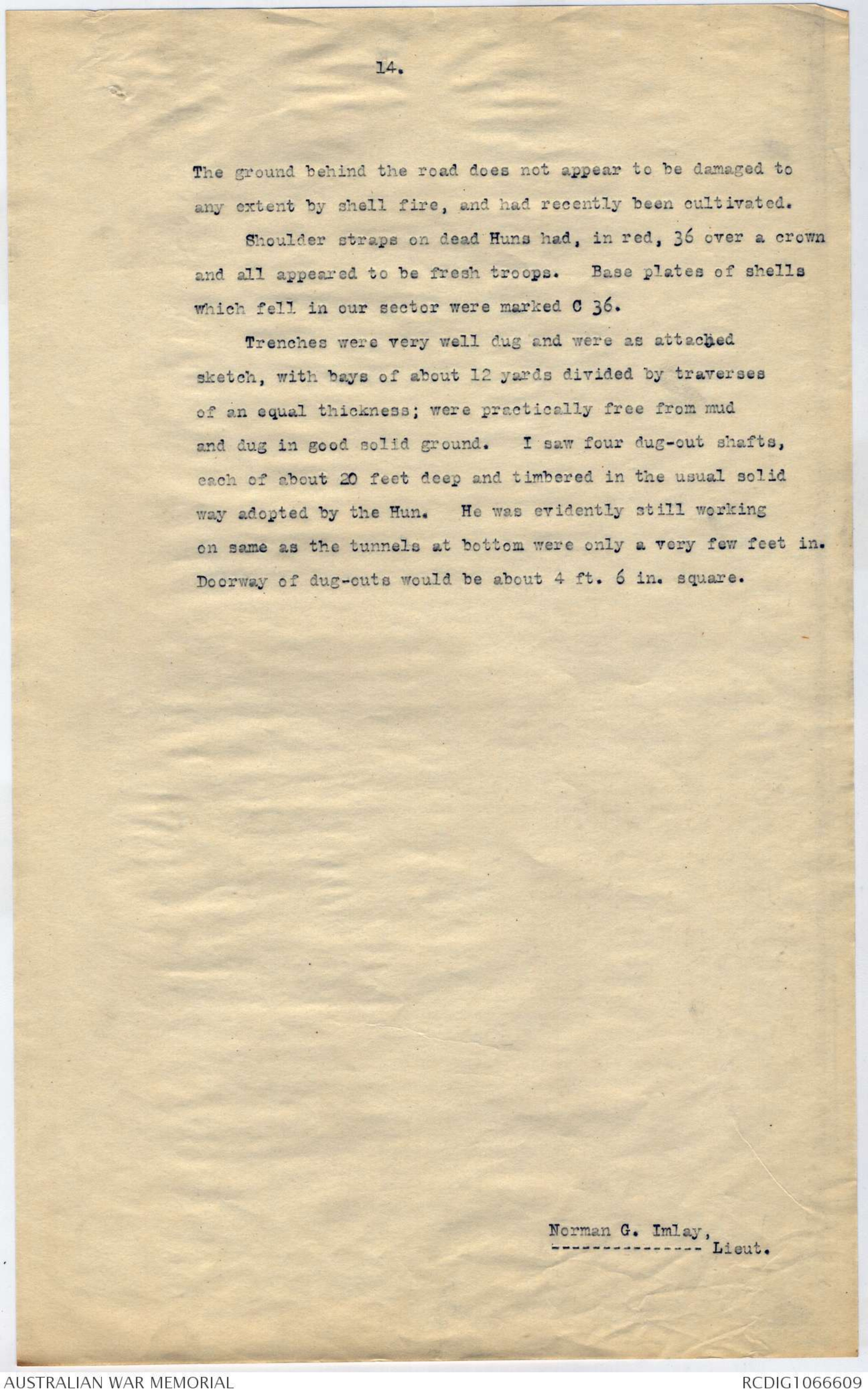
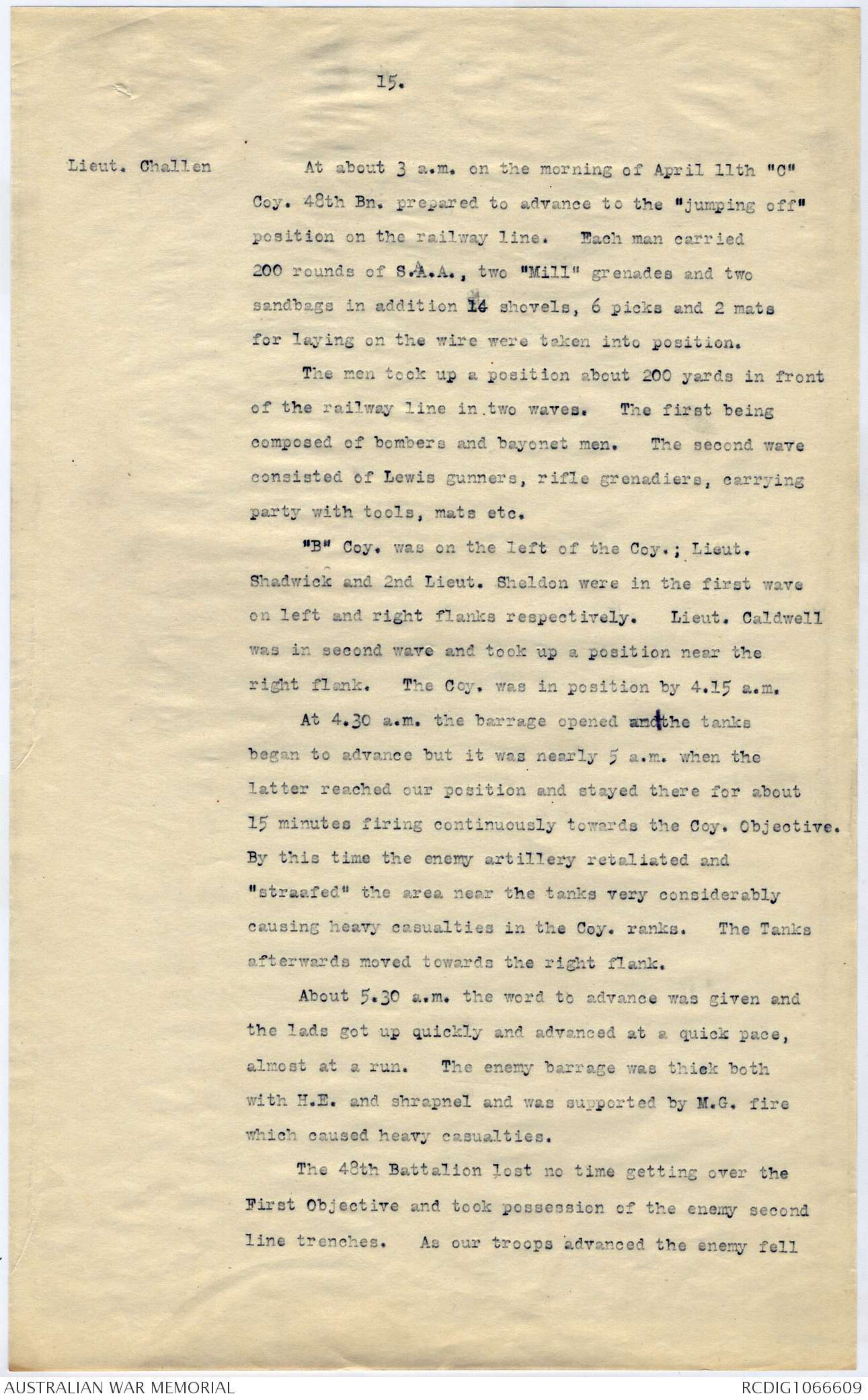
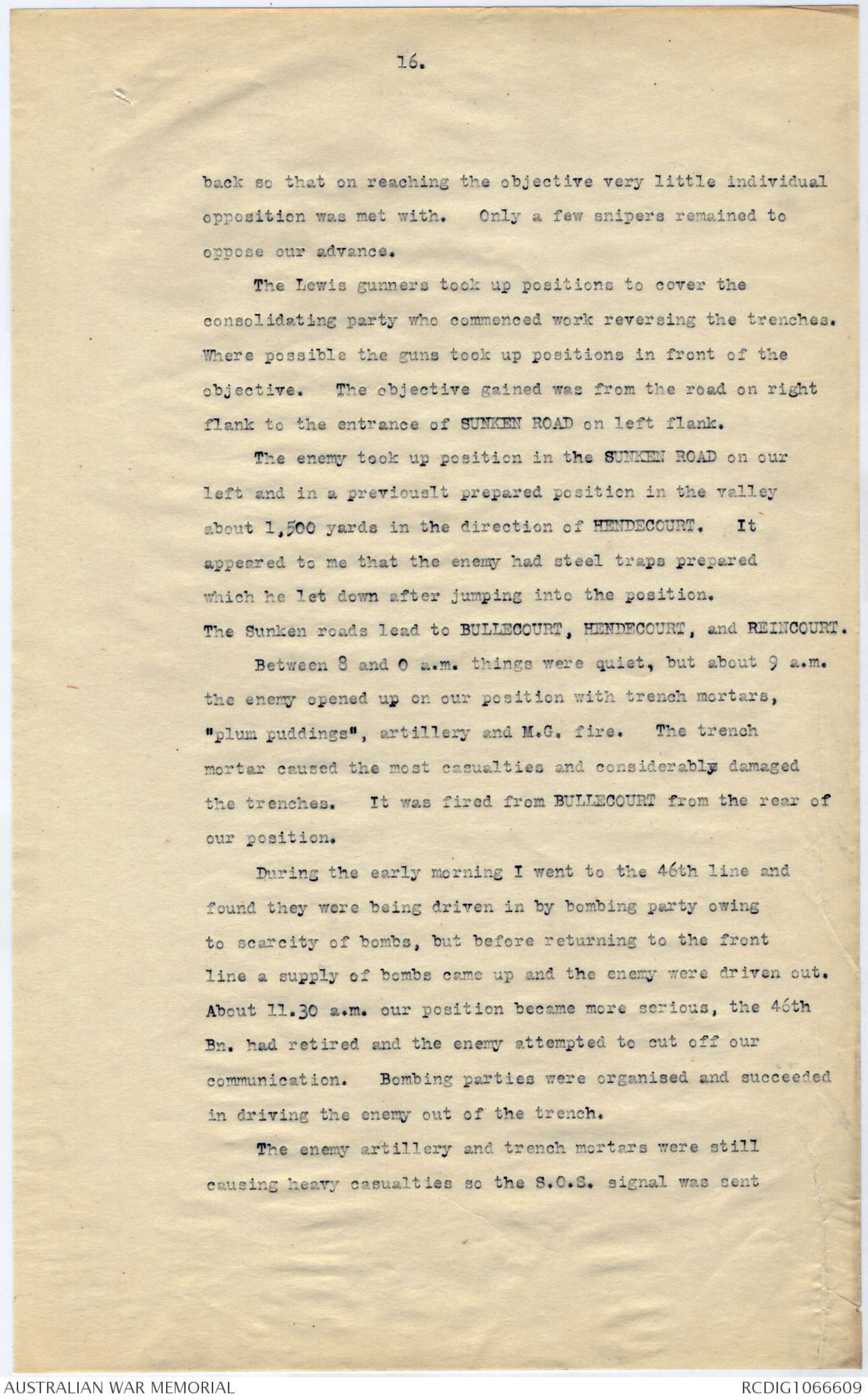



10.
was made to get in touch with 4th Bde. but nothing could be
done. From observation I should say that this Brigade was at
least 400 yards to the right of the point they should have
been. Between my Battalion and this point the line was
strongly held by the enemy and constant bombing attacks were
made, all were driven off with considerable loss. At 9.30 a.m.
I instructed my Intelligence Officer to go forward and send
me a report of the position and the map reference of Right and
Left. This officer reported that a body of men, approximately
a battalion were marching from the direction of HENDECOURT.
Capt. Leane reported trenches on right and left strongly held
and expects a counter-attack. This information I telephoned
to Brigade, and repeated by wire I asked that some support
be given on left immediately, otherwise doubted if the trenches
could be held. However this was not forthcoming. At 11.15
a.m. I wired that 4th Brigade and 12th Brigade were retiring.
I could see this from my position. The 46th Bn. never informed
my Bn. of their decision - my men were placed with large
numbers of the enemy on their right and left, and the trench
in rear evacuated by the 46th Battalion was promptly regained
by the Boche. Bombing parties under officers moved down
communication trench and bombed out the Boche, working on both
flanks, and the both trenches were again in our hands, but on
account of the few men left and no communication possible except
by runner, Captain Leane decided to evacuate the 2nd Objective
and fall back and hold the 1st Objective. He knew by this time
that the 46th had retired and could see the 4th Brigade going
back but decided to hold on to the one trench hoping for
assistance later. At 12.5 he despatched a wire "Our artillery
11.
is making trench untenable" and at 12.25 he had to retire.
The officers and a few bayonet men remaining to cover the
retirement. My Battalion held the trenches 1 hour 10 minutes
after the rest had retired. No words of mine can express the
pride and admiration I feel for these brave men, officers and
men alike did wonderful work and I feel that had troops come
up on the left of BULLECOURT and captured the trench we
would still be in the position. The failure in my opinion
was due to:-
(1) Tanks not carrying out their work.
(2) Failure of British to attack left of BULLECOURT.
I am forwarding names of officers and other ranks whom I
consider worthy of special recognition. During the afternoon
and evening volunteers from the Battalion worked over No Man's
Land to the enemy wire, rescuing and bringing in the wounded,
despite the fact that they were sniped at and fxxx fired
on with machine-guns. A great number of our wounded, also
46th and 47th, were brought in.
Raymond L. Leane
Lieut.-Colonel
Commanding 48th Battalion.
In the Field
13/4/7.
12.
Report on Operations 11th April 1917.
I left with Ammunition Party at 7.30 a.m., whole party arrived
[*Lieut. Imlay*] and handed S.A.A. to Lewis gunners. The situation in 48th
trench was fairly quiet but a bombing party under Lieut.
Dennis was still working down towards BULLECOURT. Made a tour
of 48th Sector and found several Lewis Guns in action in trench
and three in shell holes outside. Two guns were out of action
having been damaged by shell fire. These were taken to pieces
and a complete gun put into action from the undamaged parts.
I ordered men to collect ammunition from casualties so as to
have a reserve supply. Had been in the trenches about 1½ hours
when an intense bombardment was put on to sector coming from
the direction of BULLECOURT and enfilading our trench
practically from end to end. This artillery was at first
thought to be our own, and on realising that it came from the
enemy ^the trenches were patrolled by the officers. At this stage
men from the 46th Battalion Sector were seen to be giving
themselves up to the enemy. Considering that the 46th Bn.
men who were surrendering did not have sufficient cause I
ordered some of my men to fire on them but am unable to say
with what success. A general counter-attack was in progress
and Germans in fairly large numbers were seen to be coming
down from the direction of RIENCOURT and were fired on by
our Lewis gunners - several were seen to fall. Then a large
number of men were observed in front of the 4th Brigade
sector, and were at first thought to be reinforcements for that
Brigade. However, on closer observation it was seen that
there were a number of Germans amongst them, and were rounding
the Australians up and sending them behind their (the German)
lines, where they were collected and marched towards REINCOURT.
13.
It was reported that the 46th had evacuated and on investigation
this was found to be correct. The Germans were vigorously
bombing on both flanks and as our supply of bombs was short it was
decided to hold the first line only. This was done until the
supply of bombs on the right gave out. It was then realised that
without bombs the position could not be held, and the order was
given to retire. The retirement was carried out under intense
machine-gun and rifle fire, also a fair amount of small artillery
fire.
The tanks do not seem to have co-operated with the infantry
as was expected. I saw no signs of them having been inside
the Huns wire. The wire was fairly well cut by artillery fire
though most of the wooden standards were still erect. The first
line of trenches was still were very little damaged by our
artillery.
REINCOURT seems to be a large centre for the Hun as horse
transport was seen to leave there and proceed in the direction
of BULLECOURT. The road was apparently in good order as the
vehicle was travelling fairly fast. Two Germans were seen to
stop this vehicle and it then turned about and returned towards
REINCOURT at a hand gallop. Just in front of our sector there was
situated a factory and several small out buildings. These were
occupied by snipers who accounted for a fair number of our men.
About 100 yards to the left of/the factory the road disappeared
behind a ridge and went on towards BULLECOURT.
Germans, with full packs up, were observed coming from the
direction of BULLECOURT and proceeding towards REINCOURT. The
fire was opened on these and several were seen to fall. After
this the Huns came in ones and twos and made dashes over exposed
places; however, our Lewis gunners accounted for several of them.
14.
The ground behind the road does not appear to be damaged to
any extent by shell fire, and had recently been cultivated.
Shoulder straps on dead Huns had, in red, 36 over a crown
and all appeared to be fresh troops. Base plates of shells
which fell in our sector were marked C 36.
Trenches were very well dug and were as attached
sketch, with bays of about 12 yards divided by traverses
of an equal thickness; were practically free from mud
and dug in good solid ground. I saw four dug-out shafts,
each of about 20 feet deep and timbered in the usual solid
way adopted by the Hun. He was evidently still working
on same as the tunnels at bottom were only a very few feet in.
Doorway of dug-outs would be about 4 ft. 6 in. square.
Norman G. Imlay,
Lieut.
15.
[*Lieut. Challen*] At about 3 a.m. on the morning of April 11th "C"
Coy. 48th Bn. prepared to advance to the "jumping off"
position on the railway line. Each man carried
200 rounds of S.A.A., two "Mill" grenades and two
sandbags in addition 14 shovels, 6 picks and 2 mats
for laying on the wire were taken into position.
The men took up a position about 200 yards in front
of the railway line in two waves. The first being
composed of bombers and bayonet men. The second wave
consisted of Lewis gunners, rifle grenadiers, carrying
party with tools, mats etc.
"B" Coy. was on the left of the Coy.; Lieut.
Shadwick and 2nd Lieut. Sheldon were in the first wave
on left and right flanks respectively. Lieut. Caldwell
was in second wave and took up a position near the
right flank. The Coy. was in position by 4.15 a.m.
At 4.30 a.m. the barrage opened and/the tanks
began to advance but it was nearly 5 a.m. when the
latter reached our position and stayed there for about
15 minutes firing continuously towards the Coy. Objective.
By this time the enemy artillery retaliated and
"straafed" the area near the tanks very considerably
causing heavy casualties in the Coy. ranks. The Tanks
afterwards moved towards the right flank.
About 5.30 a.m. the word to advance was given and
the lads got up quickly and advanced at a quick pace,
almost at a run. The enemy barrage was thick both
with H.E. and shrapnel and was supported by M.G. fire
which caused heavy casualties.
The 48th Battalion lost no time getting over the
First Objective and took possession of the enemy second
line trenches. As our troops advanced the enemy fell
16.
back so that on reaching the objective very little individual
opposition was met with. Only a few snipers remained to
oppose our advance.
The Lewis gunners took up positions to cover the
consolidating party who commenced work reversing the trenches.
Where possible the guns took up positions in front of the
objective. The objective gained was from the road on right
flank to the entrance of SUNKEN ROAD on left flank.
The enemy took up position in the SUNKEN ROAD on our
left and in a previouslt prepared position in the valley
about 1,500 yards in the direction of HENDECOURT. It
appeared to me that the enemy had steel traps prepared
which he let down after jumping into the position.
The Sunken reads lead to BULLECOURT, HENDECOURT, and REINCOURT.
Between 8 and 0 a.m. things were quiet, but about 9 a.m.
the enemy opened up on our position with trench mortars,
"plum puddings", artillery and M.G. fire. The trench
mortar caused the most casualties and considerably damaged
the trenches. It was fired from BULLECOURT from the rear of
our position.
During the early morning I went to the 46th line and
found they were being driven in by bombing party owing
to scarcity of bombs, but before returning to the front
line a supply of bombs came up and the enemy were driven out.
About 11.30 a.m. our position became more serious, the 46th
Bn. had retired and the enemy attempted to cut off our
communication. Bombing parties were organised and succeeded
in driving the enemy out of the trench.
The enemy artillery and trench mortars were still
causing heavy casualties so the S.O.S. signal was sent
17.
up. Our artillery did open up but played havoc with our
position, so that it was decided to hold the First Objective.
Bombing parties held the flanks while the movement was
carried out and this position was held until 12.25 p.m.
when the order to withdraw was given.
L. Challen,
Lieut.
[*2nd Lt. Sheldon*] In the attack on the enemy lines on right of BULLECOURT
by 46th and 48th Battalions I was in charge of No. 9
Platoon "C" Coy. of 48th Battalion on the extreme right
flank of the attacking line. Advancing across No-Man's
Land we passed through the enemy barrage of shell, machine-gun
and rifle fire and had very heavy casualties.
When we arrived at our objective, the German support
line, we found that the enemy had already evacuated and we
established at the road which runs through the enemy line
at U 23 c 85 05. Lewis guns were placed to cover our flank
and one gun was sent forward in front of our line about
30 yards to enfilade the enemy support line on our right.
A bombing post was established at U 23 c 85 05 on the road
to prevent enemy bombing parties entering the trench.
The riflemen dug a firestep on the reverse side of the
trench, and our consolidation was complete within half
an hour of our occupation of the trench.
Our Lewis guns and rifles were very effectively
employed in dispersing enemy working parties, and bodies
of men which could be seen behind his lines. At 9.30 a.m.
a count was made and a total of 9 officers and 218 other
ranks was reached. Between 8 a.m. and 0 a.m. the
situation was quiet. After 0 a.m. the enemy fired trench
18.
mortar bombs into the line held by the 46th Bn. and into
the communication trench between the two lines. A battery
of field guns which was situated in or near the village
of BULLECOURT enfiladed our line with H.E. and "whiz-bangs"
doing considerable damage to the trench.
Between 11 and 11.30 a.m. the 46th Bn. evacuated
their line without informing us of their intention to do so
until they had gone, when a runner from the 47th Bn.
reported to Captain Leane that the 46th Bn. had evacuated.
Immediately a bombing party was organised and the
trench evacuated by the 46th Battalion was cleared of
the enemy. At 12.25 a.m. finding that the position was
untenable, we retired leaving our wounded in the trench
owing to our inability to remove them. Bombs were found
in the line which had been occupied by the 46th, and I am
of the opinion that they were not justified in leaving
the line, and that they could have held on.
The enemy trenches are about 5 ft. wide at bottom
and 8 ft. at top, with a depth of 8 ft. They have
a firestep and are in first class order. The support
line occupied by us had four dug-out xxxxxxx entrances
all of them being in the course of construction. No
tunnels have been dug. Had the attack on the left of the
village been successful we should have had no difficulty
in holding our position, and eventually in capturing
the village.
Enemy working parties were observed constructing
wire entanglements about 1,800 yards in front of the
village of HENDECOURT-LES CAGNICOURT.
C. Sheldon,
2nd Lieut?
19.
[*Lieut. McKenzie*] All ranks were in their positions by 4.30 a.m.
and ready to advance, but the advance of the second
wave of the 48th Battalion did not commence till 5 a.m.
We advanced in the rear of "C" Coy., passed through the
enemy front line entanglements with ease and entered
the enemy second line trench which had already been
occupied by "B" and "C" Coys. and was at that time clear
of the enemy.
Under the orders of Captain Leane I took charge
of the left flank of "C” Coy. and "D" Coys. and
proceeded to make a firestep while Lieut. Jones on the
right flank organised a bombing party to work in the
direction of the 4th Brigade. A block was established on
this flank at the SUNKEN ROAD.
Shortly after this it was reported that the
left flank of the 46th Bn. was being driven out behind
us, so Captain Leane sent me to find out how matters
stood. The officer in charge of that flank said that
the enemy had attacked his flank but, as they (the 46th)
had got some more bombs they would be able to hold
against the enemy.
On my returning from the left flank of the 46th
I met Lieut. Imlay with a party carrying ammunition
for Lewis guns. I guided this party back to Coy. Hqrs.
There was a lull in the action at this time for about
an hour after which (at 9 a.m.) the enemy opened a
bombardment with light field guns causing many
casualties. These guns appeared to be firing from
the direction of BULLECOURT.
Shortly after 11 a.m. the 46th Bn. were seen
retiring from their position on our right. Shortly
after this the enemy renewed their attack on the 46th
Bn. on the left who retired.
 Sam scott
Sam scottThis transcription item is now locked to you for editing. To release the lock either Save your changes or Cancel.
This lock will be automatically released after 60 minutes of inactivity.